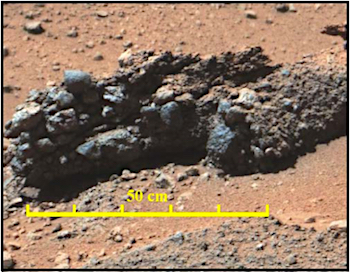 The presence of water on Mars has been theorized for centuries. Early telescopes revealed ice caps, and early astronomers noted channels that were hypothesized to be natural rivers or creature-created canals. (…)
The presence of water on Mars has been theorized for centuries. Early telescopes revealed ice caps, and early astronomers noted channels that were hypothesized to be natural rivers or creature-created canals. (…)
Since its landing on the “Red Planet” in August of 2012, Curiosity Rover has traveled about 20 kilometers within Gale Crater. The rover has examined about 400 meters of sedimentary rock that exists in the crater, says Ezat Heydari of Jackson State University in Jackson, Mississippi — including rocks thought to be 3.7 to 4.1 billion years old (Noachian time).
Heydari and colleagues used these images of sedimentary rocks to interpret the geologic processes that occurred billions of years ago on Mars. He presented their findings on Sunday [November 4] at the Geological Society of America Annual Meeting in Indianapolis, Indiana.
Within those 400 meters of rock, the researchers identified four different units that represent different types of deposition, and Heydari says that “in my opinion, deposition of all of these packages involved water.”
One of those packages, called the Hummocky Plain Unit, is a conglomerate with grains up to 20 centimeters in size. The Curiosity images showed ridges in the Hummocky Plain Unit, filled with rounded cobbles and cross beds reaching 4 meters high— indications that deposition was done by moving water.
In addition, some of the images have height information that can create a topographic profile of the surface, revealing the profiles of the ridges. “These ridges are asymmetric,” says Heydari. “In other words, they were formed by one directional current.” [More at links]








